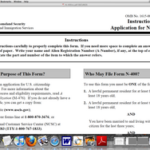Answering questions about United States history, government, and geography should be a snap if you were born and educated here, right?
Maybe not.
Last month, the U.S. Citizenship and Immigration Services (USCIS) issued an overhauled test for applicants seeking to become American citizens. According to an article in the September 28 Washington Post by Karin Brulliard, those who apply after October 1, 2008 will face an exam with more “why” than factual-type questions. One example: “What does the President’s Cabinet do?”
Brulliard says about 700,000 individuals became naturalized American citizens last year. The test is normally conducted orally and in English. She indicates that the new test includes 100 potential questions. Individuals who pass must correctly answer 6 out of a total of 10 questions selected at random.
According to the Post, the old test, with a pass rate of 84 percent, encouraged applicants to practice rote memorization of the questions and answers provided for them to study. The new exam, with a 92.4 percent passing rate for the pilot program, was designed to be more concept-oriented.
It’s not without criticism, however. When interviewed by Brulliard, Fred Tsao, policy director for the Illinois Coalition for Immigrant and Refugee Rights, stated the organization was “deeply disappointed” with the exam after being one of the organizations consulted during its development. He insisted some of the final questions, such as “What is a rule of law?” are overly abstract.
All 100 questions and acceptable answers are now posted at the USCIS web site. Individuals who are at least 65 years old and who have been a legal permanent U.S. resident for a minimum of 20 years are only responsible for a shorter set of questions.
USCIS suggests the new test is not harder than the current one. It maintains the upcoming exam will probe more deeply to measure would-be citizens’ understanding of democratic values.
For many, the responses will be a snap. But even those born and educated within U.S. borders might have trouble coming up with on-the-spot answers to some of the following questions posted at the USCIS site:
1. How many amendments does the Constitution have?
2. What is the “rule of law”?
3. Name your U.S. Representative.
4. Under our Constitution, some powers belong to the federal government. What is one power of the federal government?
5. There are four amendments to the Constitution about who can vote. Describe one of them.
6. What are two rights only for United States citizens?
7. What are two ways that Americans can participate in their democracy?
8. The Federalist Papers supported the passage of the U.S. Constitution. Name one of the writers.
9. Name one state that borders Canada.
10. Who was President during World War I?
11. What did Susan B. Anthony do?
12. There were 13 original states. Name three.
Half the questions on the new test were revised from those on the current exam, according to Brulliard. The rest are new. The pilot program conducted in 10 cities earlier this year included 142 questions. After officials analyzed the responses of 6,000 applicants who volunteered to take the pilot exam, they discarded and revised a number of questions before producing the final 100.
Reference:
- “New Citizenship Test to Begin Next Fall, ” by Karin Brulliard, The Washington Post, September 28, 2007, page A-2.




